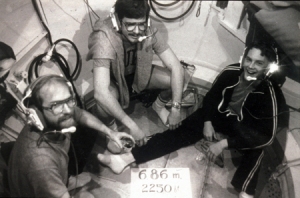
I once met the Father of the U.S Remote Viewing program, unawares.
A decade ago, at the request of a Navy engineer who ended up being a character in my novel Middle Waters, I invited Dr. Harold E. Puthoff into the Navy Experimental Diving Unit to give a talk on advanced physics. He had attracted a small but highly educated and attentive crowd which, like me, had no idea that the speaker had once led the CIA in the development of its top secret Remote Viewing program.
Of late, Puthoff’s energies have been directed towards the theoretical “engineering of space time” to provide space propulsion, a warp drive if you will. Although strange by conventional physics standards, similar avant-garde notions are receiving traction in innovative space propulsion engines such as NASA’s EMdrive.
Puthoff is the Director of the Institute of Advanced Studies at Austin, in Texas, but before that, and more germane to this discussion, Puthoff was a laser physicist at the Stanford Research Institute. It was there that the CIA chose him to lead a newly created Remote Viewing program, designed to enable the U.S. to maintain some degree of competiveness with Russia’s cold war psychic spying program.

Psychic spying was purportedly the method used by the two superpowers to visualize things from a distance; not from a satellite, but from what some call the highly developed powers of the mind’s eye. If we believe what we read on the subject, Remote Viewing was eventually dropped from the US psychic arsenal not because it had no successes, but because it was not as reliable as signal intelligence (SIGINT), satellite imagery, and spies on the ground. But, it has been argued, it might be ideal in locations where you can’t put spies on the ground, such as the dark side of the moon, or the deep sea .
Serendipitously, as I started writing this blog post, Newsweek published a review of the Remote Viewing efforts of Puthoff and others in a November 2015 issue. The article seemed fairly inclusive, at least more so than other articles on Remote Viewing I’ve seen, but the Newsweek author was not particularly charitable towards Puthoff. Strangely, the strength and veracity of Puthoff’s science was reportedly criticized by two New Zealand psychologists who, as the Newsweek author quoted, had a “premonition” about Puthoff.
“Psychologists” and “premonitions” are not words commonly heard in the assessment of science conducted by laser physicists, especially those employed by the CIA. The CIA is not stupid, and neither are laser physicists from Stanford.
To the extent that I am able to judge a man by meeting him in person and hearing him talk about physics, I would have to agree with Puthoff’s decision to ignore his ill-trained detractors. Every scientist I know has had detractors, and as often as not those detractors have lesser credentials. Nevertheless, I have the good sense to not debate the efficacy of remote viewing. I don’t know enough about it to hold an informed opinion. However, there seems to be some evidence that it worked occasionally, and for a science fiction writer that is all that is needed.

As my curiosity became piqued by the discovery of the true identity of my guest speaker at NEDU, and as I learned what he had done for the U.S. during the Cold War, I thought of another great physicist, Enrico Fermi, one of the fathers of the atomic bomb. In the midst of a luncheon conversation with Edward Teller, Fermi once famously asked, “Where are they?” The “they” he was referring to, were extraterrestrial aliens.
What became known as Fermi’s Paradox went something like this: with all the billions of stars with planets in our galactic neighborhood, statistically there should be alien civilizations everywhere. But we don’t see them. Why not? “Where are they?”
In most scientists’ opinions, it would be absurdly arrogant for us to believe we are the only intelligent life form in the entire universe. And so ETs must be out there, somewhere. And if there, perhaps here, on our planet, at least occasionally. And that is all the premise you need for a realistic, contemporary science fiction thriller.
But then there is that pesky Fermi Paradox. Why don’t we see them?
Well, they could indeed be here, checking us out by remote viewing, all the while remaining safely hidden from sight. After all, as one highly intelligent Frog once said, humans are a “dangerous species” —fictionally speaking of course.
That “hidden alien” scenario may be improbable, but it’s plausible, if you first suspend a little disbelief. If we can gather intelligence while hiding, then certainly they can, assuming they are more advanced than humans. A technological and mental advantage seems likely if they are space travelers, which they almost have to be within the science fiction genre. Arguably, fictional ETs may have long ago engineered space-time, which could prove mighty convenient for tooling around the galactic neighborhood.
So, if in the development of a fictional story we assume that ETs can remote view, the next question would be, why? Is mankind really that dangerous?
Well, I don’t intend for this post to be a spoiler for Middle Waters, but I will say that the reasons revealed in the novel for why ETs might want to remote view, are not based on fear of humans, but are based on sound science. From that science, combined with a chance meeting with Hal Puthoff, the basic premise of a science fiction thriller was born.
So, to correct what some of my readers have thought, I did not invent the concept of “remote viewing”. It is not fictional; it is real, and was invented and used by far smarter people than myself, or even that clever protagonist, Jason Parker.



